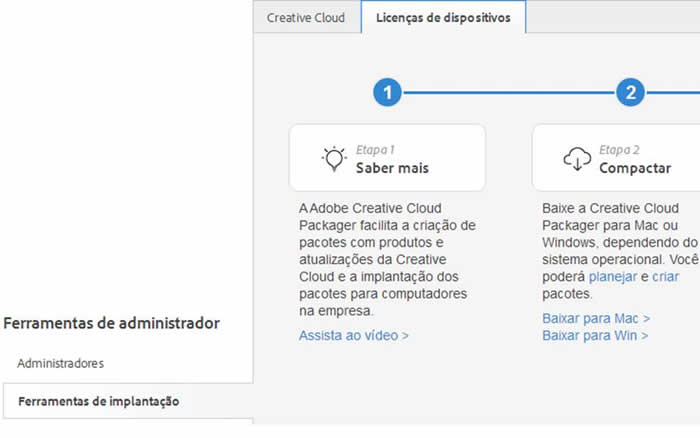
Creative Cloud Packager For Mac
Jun 15, 2016
Topics Introduction. Introduction; Create and customize packages; Deploy Packages; Manage Updates; Creative Cloud Packager; Troubleshooting. When you create a package with Adobe Creative Cloud Packager, two folders are created: The Build folder contains the MSI (Windows) or the PKG (Mac OS) file for deployment with Microsoft SCCM or Apple ARD. The Exceptions folder contains the payloads that must be installed separately.
Hi All,
As Staind once said “It’s been awhile”. The last update had some exciting information regarding support for multi language packages and Acrobat workflow improvements. This update is also quite exciting, of course context is everything and so when I say exciting I mean as exciting as a post about a redesigned installer technology can possibly be, so put down that big inflatable party finger.
We have today released a number of updates for the Enterprise IT Tools. For a quick summary please have a look at the video below (monotone is for life not just videos)
Alternative Video Link:https://spark.adobe.com/video/H18A3i04
If you are more of a text person then this bit is for you
Creative Cloud Packager (1.9.5) (Release Notes)
The main focus for this release was to support a completely redesigned version of Adobe’s proprietary installer technology. We are really excited about the capabilities that can be seen in this first phase of the redesign but also the long term capabilities we can provide to customers. For today however the headline feature for this change is that we have
- Cut the install time of the Creative Cloud applications by roughly 50%.
In most cases it is actually more the 50% which is quite an astonishing improvement.
- Updates for these products will now also be full installers.
Meaning when you package an update for a product you will now see a new icon . When you see this icon it means the installer can be used to install the update on a system that has the software already but also on a system that does not already have the base version. The installer redesign means smaller packages so the difference between the previous patch versions and new full installers is negligible but it does mean you no longer need to have both update packages and base version installs.
Over the next little while you will see the Creative Cloud products adopting the installer changes and we have a list documented on our help page.
- Added support for Adobe Experience design in CCP
You can now use CCP to package the Adobe Experience design Preview
AUSST 4.0
It is great to be able to release a few new features for AUSST our beloved tool for hosting an internal update server.
- Added support for application binaries.
As I mentioned above updates now have a dual purpose and so we have leveraged this to also allow AUSST to support application binaries. In the context of a workflow, if your end users are using the Creative Cloud desktop application for self service then when they go to install let’s say the latest version of Photoshop and you have an internal server then the application will actually install via your internal server versus going out to Adobe every time to download the application bits. We have plans to allow more granularity with AUSST so you can specify just the application you want to sync versus all applications so look out for this soon.
- Support for Acrobat DC updates (Windows only)
This has been a feature requested for quite some time so we are delighted that AUSST now allows you to host updates for both Creative Cloud and Acrobat. We are working hard to add support for Mac updates so expect this is the not too distant future.
Deployment dashboard
As you hopefully know, within the Enterprise Dashboard we have a deployment section that facilitates the download of pre-created packages.
- Pre-Created packages for all applications
We have now tweaked the logic so you see not just the applications you purchased but all applications. Previously if you just purchased Creative Cloud complete but only wanted a Photoshop package you would need to use CCP. Now we show you all packages so you can choose the ones you specifically want.
- Cut the time it takes for customisation by up to 30%
Actually…. I take it back. This is something to get excited about. Pick up that big inflatable party finger and wave it like you just don’t care.
Finally (told you that you should have watched the video) we are really excited to be sponsoring the 2016 MacAdmins conference at Penn State and so I look forward to seeing you all there.
Cheers
Karl Gibson Senior Product Manager Creative Cloud Enterprise
Dec 21, 2012
You are at your holiday party. You have had one, okay, more than one, glass of spiked eggnog. You are singing along to Wham!’s “Last Christmas” off key. Let’s face it, your judgement might be slightly impaired. And of course, as an IT admin, your goal is to avoid talking to your production manager at these type of events. Too late. He’s cornered you. Oh, that tie! Does he think he is being ironic wearing that Santa tie?
And the next day when you awake you have a slight flashback. What did I promise? Something about telling the production manager I would deploy Adobe’s Creative Cloud for teams before I left for my break. How can you package up and deploy the “cloud?” That doesn’t even make any sense. Oh my head. The nog!
Well I hope this blog will be your Rockstar Recovery drink to get you through this. First, let’s clarify a few things. First, the Creative Cloud for teams offering is different the Enterprise offering. We’ll have a few blog posts going into the Enterprise offering in 2013. This post is simply focused on what an IT admin who has to help roll out the Creative Cloud for teams can do with the existing Adobe IT tools like AAMEE and RUM to make things easier. We’ll be rolling out comprehensive documentation in January on this topic but want to give a quick overview.
Let’s say you are rolling out 50 seats of Creative Cloud for teams in your office. You may be involved with the actual administration of sending out invites. This is done through the admin portion of the Creative Cloud site. From the Invite Multiple option you can either copy and paste user’s email addresses (ouch! carpal tunnel) or import a .txt or .csv file of the user’s email address. Then you can send them an invite and they’ll login with or create an Adobe ID.
Then they’ll download and install the Creative Cloud version of the Adobe Application Manager and begin downloading and installing the full offering of Adobe’s Creative Cloud applications and updates. All of them. All of the apps. All at once. All 50 of the users. What? This is in your Portland office? The only office that hasn’t had the network upgrade yet. Better turn off your mobile stat and hide.
Now that scenario of course could be avoided if you used your existing deployment infrastructure by pushing out packages of the apps rather than using your office’s internet connection for all 50 users. But how do you package up a set of apps that come from the cloud? Ah, you need a work-a-round, a hack. Well my friend, as a former IT admin I am all about the hack. Here’s how you do it: The bulk of the applications they are downloading from the Creative Cloud are the CS6 installers and to be frank, are not exactly what I’d call svelte in the MB/GB department. So you could download them yourself from our FTP site as the CS6 Master Collection and then use AAMEE 3.1, our CS6 packager, to package them out and distribute them.
But wait, AAMEE requires a volume serial number, right? Well remember we also have a Trial workflow in AAMEE 3.1. And the Trial workflow is really an unlicensed version of the CS6 app, just waiting for licensing via a serial number or an Adobe ID login associated with a subscription or Creative Cloud membership. Get it? So once it is packaged up you can distribute using your deployment infrastructure and then have them log in after you send the invites. This turns the unlicensed CS6 app into a Creative Cloud app. Magic. More like magic hack.
A few caveats about this plan/hack are:
1) apps such as the Edge tools, Muse and Lightroom aren’t part of CS6 so the end-users will have to download those apps on their own. The Edge tools and Muse are quite lightweight in size though.
2) the updates that you package with AAMEE 3.1 will not fully get the applications up to date. Why? Because the Creative Cloud have their own special feature updates that are not part of CS6. Therefore they can’t be seen in the Updates screen with the CS6-based AAMEE 3.1. You could execute the Remote Update Manager (RUM) once the end user has signed into the application with a valid Creative Cloud account. Then when you run RUM it will recognize the install as a Creative Cloud app and then pull that Creative Cloud-specific update down and install it.
(There is obviously a joke opportunity in there with RUM and spiked eggnog but I am going to refrain. Not because I am opposed to stupid jokes. Anyone who has read this blog in the past knows that. But this is out of principal. And that is because I am in the camp that firmly believes eggnog only has one true friend. And that friend is from Loretto, Kentucky. I’ll say no more.)
If you have read through this blog post cursing me and saying things aloud saying things like “Don’t you know my end-users aren’t admins?” or “There is no way we would give our users access to whatever apps they want.” or “I don’t want my users to have to have Adobe IDs.” If that is the case, then we have an Enterprise version of the Creative Cloud that can accommodate your organization. Lots more info on this topic coming early 2013 including us previewing some cool new stuff at the Mac IT event in San Francisco which we are are a sponsor.
If you are not familiar with our FTP site, you can get to the CS6 installers by going here:
And if you are unfamiliar with AAMEE you can download it here along with the tome that is the Enterprise Deployment Guide that covers AAMEE, RUM, and more:
Hope this hack helps. That is a lot of ‘h’ action. Here’s two more: Happy holidays!
Jody Rodgers Sr. Product Manager Enterprise + Volume Digital Media Adobe Systems
UPDATE: The PDF of the white paper “Adobe Creative Cloud for teams IT Deployment Guide” is live:
2nd UPDATE 3/6/13: Two issues with the workflow mentioned, both fairly major. First, the media that is on the FTP is not for North American English. We are working to get that posted on the FTP site. In the meantime, you can find the CS6 MC media from: http://www.adobe.com/downloads/
[Note: Getting media from that page requires the use of the Adobe Download Assistant which is very consumer focused. Sorry about that.]
Second, in order to have the ability to login properly with a Creative Cloud for Teams account the system needs to have the latest copy of Adobe Application Manager installed. Unfortunately the Adobe Application Manager can’t be packaged with AAMEE nor is it a native installer. I know, I know! Here are the links to the Adobe Application Manager files:
Windows: http://www.adobe.com/support/downloads/detail.jsp?ftpID=4773
Mac: http://www.adobe.com/support/downloads/detail.jsp?ftpID=4774
It can be installed from command line by:

